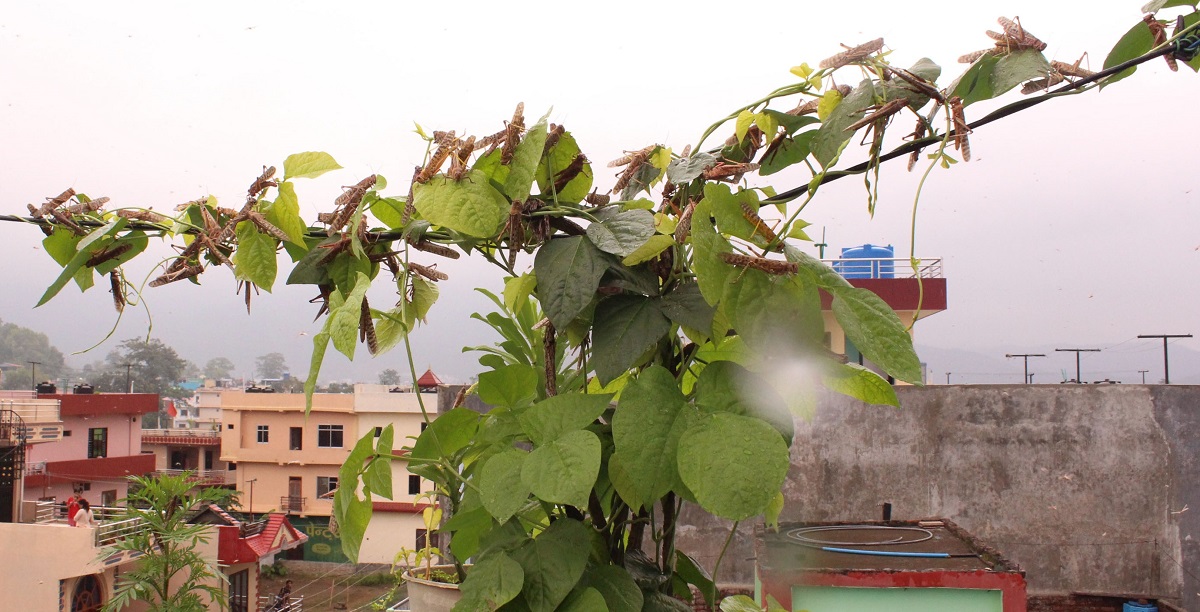KATHMANDU: The swarms of locust that entered Nepal crossing the borders of India from Africa via Gulf countries on Saturday, June 27 has caused damage to 53 districts so far in Nepal.
In 10 days, the plague of destruction had expanded to 53 districts even though the damage caused in 5 districts is regarded as remarkably high.
If the data of the Plant Quarantine and Pesticides Management Center (PQMC) is to be considered, nearly 8 million of these insects have managed to spread in different parts of the country.
According to Ram Krishna Subedi, the Information Officer at PQPMC, they have been assessing the damage caused by the locusts in coordination with Agriculture Knowledge Center, technicians at local levels and the farmers.
“As per the details we received from the 5 most-affected districts, the crops and vegetables of nearly 1,118 hectares have been spoilt by these insects.”
He informed that despite expanding their wings in 53 districts, the locusts have reached in swarms only in 27 districts.
The damage is not equal everywhere as the insects have done minor damages in some places, according to Subedi adding that the details of damaged caused in districts like Rukum, Rolpa, and Salyan has not been ascertained so far.
Experts, meanwhile, said that the locusts failed to get a conducive environment in Nepal as the monsoon is active here. The locusts cannot fly when they get wet as they cannot flap the wings. This leads to the end of locusts.
The assessment of the damage
The locusts, which first appeared in Bara some 10 days back, have spread almost all over the country now. Initially, the farmers were panicked at the idea that the locusts can fly in the swarms of nearly 40 million in a group.
Subedi, meanwhile, regards this as fortunate that the monsoon was active at a time when locusts entered Nepal. Moreover, the swarms that entered Nepal turned far smaller than their usual trend.
The damage assessment shows that locusts made the largest damage in Dang.
The cornfield spread in around 580 hectares and the vegetable farming in similar areas have been spoilt in Dang whereas the locusts have damaged the cornfield spread nearly in 105 hectares and the vegetable farming in a similar area in Makawanpur district.
The plaguing insects have destroyed corn and vegetables in nearly 100 hectares in Arghakhanchi district as well.
According to PQPMC, Pyuthan has to bear the damage of crops and vegetables spread in around 283 hectares. Thus, Pyuthan has turned to be the second highly-affected district after Dang.
Palpa district has lost crops and vegetables planted in around 50 hectares.
In addition to these districts, Sindhuli and Rolpa have seen minor damages caused by locusts, especially in corns.
According to Subedi, the center has been collecting details of the damages and loss from the locust attack.
Wind influences movement of locusts
According to Dr. Dilli Ram Sharma, former Director-General of the Department of Agriculture, the swarms of locusts are heading back to deserts gradually.
Locusts fly in the direction of the wind; hence it’s not easy to predict their movement.
“The wind is the east-west way now, provided the wind movement remains the same, the locusts may remain few more days,” Sharma told Khabarhub.
“However, provided the wind starts flowing north to south, these insects will go out from Nepal,” he added.
Is there a chance of recurring attacks from locusts?
Former DG Sharma assesses there is less chance of locust coming back to Nepal.
According to him, grown-up locusts can survive nearly for 2 weeks. The locusts are in Nepal for more than 8 days now, hence their days are nearly over now.
“As they are in Nepal for around 10 days now, they cannot survive anymore, hence, those which can fly will fly to Rajasthan soon,” Sharma calculated.
“A grown-up locust may stay a few days more or fly back to deserts, everything depends on the movement and the direction of the wind,” he concludes.









Comment